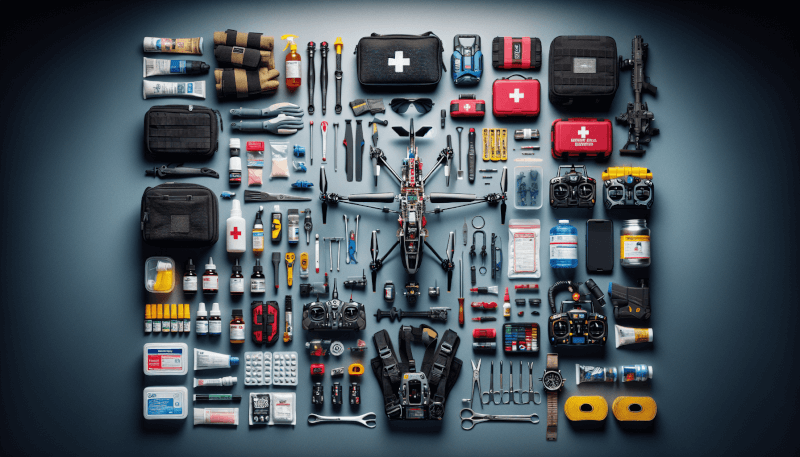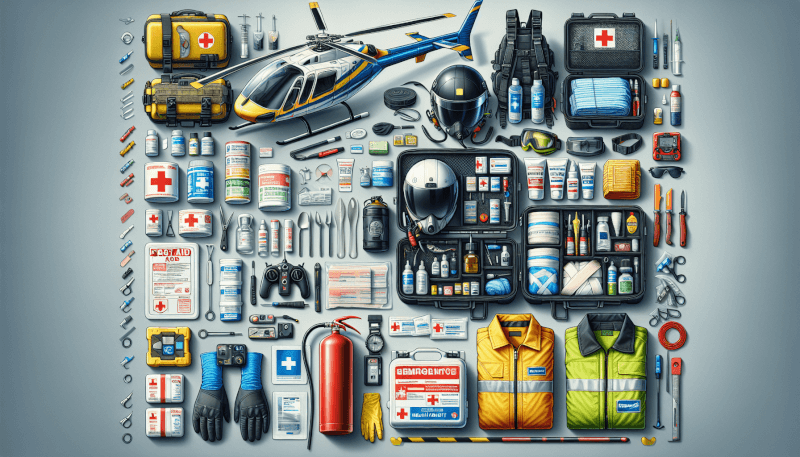Imagine this scenario: you’re out in the open, the sun shining down on a beautiful day, and you’re ready to take your RC helicopter for a spin. You’ve spent countless hours perfecting your flying skills, but have you thought about the importance of having the right first aid and safety equipment at your side? In the world of RC helicopter piloting, accidents can happen, and being prepared is crucial. In this article, we’ll explore the essential first aid and safety equipment that every RC helicopter pilot should have in their kit. From basic necessities to specialized tools, you’ll learn everything you need to ensure a safe and enjoyable flying experience. So grab a chair and let’s get started!

First Aid Kit
When it comes to RC helicopter flying, safety should always be your top priority. Accidents can happen, and being prepared with a well-stocked first aid kit can make all the difference. In your first aid kit, you should include a variety of essential items to handle minor injuries that may occur during your flying adventures.
Band-Aids
A must-have in any first aid kit, band-aids are essential for treating small cuts and abrasions. They provide protection and help to prevent infections. Make sure to include various sizes, as you never know when you might need one.
Antiseptic Wipes
Antiseptic wipes are handy for cleaning wounds before applying any bandages. They are individually wrapped, making them convenient to carry and ensuring their cleanliness. These wipes help to prevent infection and promote healing of minor injuries.
Gauze Pads
Gauze pads are useful for applying pressure to control bleeding or to dress larger wounds. They are sterile and highly absorbent, making them an important addition to your first aid kit. Different sizes of gauze pads should be included to accommodate various injuries.
Sterile Adhesive Tape
Sterile adhesive tape is necessary for securing wound dressings or gauze pads in place. It is hypoallergenic and designed to stick well without causing irritation to the skin. Having this tape on hand ensures that your dressings stay firmly in place, providing effective wound care.
Tweezers
Tweezers are essential for removing splinters, thorns, or other foreign objects that may become embedded in the skin. They allow for precise and sterile removal, reducing the risk of infection and further injury. Including a pair of tweezers in your first aid kit will come in handy for any unexpected encounters.
Safety Glasses
Protecting your eyes should always be a priority, especially when operating an RC helicopter. Flying debris, dust, and even UV rays can pose a risk to your vision. Having the right safety glasses can provide the necessary protection to keep your eyes safe during flights.
Clear Lens Glasses
Clear lens glasses are ideal for general eye protection during RC helicopter flights. They shield your eyes from any flying debris and prevent any potential eye injuries. Make sure to select a pair that fits well and stays securely in place, allowing you to focus on your flying techniques.
UV Protection Glasses
When you’re out in the sun for extended periods, it’s important to protect your eyes from harmful UV rays. UV protection glasses are designed to block out these damaging rays, reducing the risk of long-term damage to your vision. Investing in a quality pair of UV protection glasses is a wise choice for any RC helicopter pilot.
Anti-fog Coating Glasses
Flying your RC helicopter in different weather conditions can create fogging on your glasses, compromising your vision. Anti-fog coating glasses are specially designed to prevent fog build-up, ensuring that you maintain clear visibility even in challenging conditions. These glasses are a valuable addition to your safety gear, providing optimal vision during your flights.
Gloves
Working with RC helicopters involves handling components and maneuvering the controls with precision. Wearing the appropriate gloves can protect your hands from potential hazards or injuries that may occur during these activities.
Disposable Gloves
Disposable gloves are essential for maintaining hygiene and preventing the spread of germs or contaminants. They provide a barrier between your skin and any potentially harmful substances, ensuring safe handling of equipment and materials. Having a pack of disposable gloves in your flight bag allows you to handle any maintenance or repairs with confidence.
Cut-resistant Gloves
Handling sharp tools or working on intricate parts of your RC helicopter can put your hands at risk of cuts or lacerations. Cut-resistant gloves are designed with high-strength materials that provide protection against sharp edges and blades. These gloves are a valuable addition to your safety gear, providing peace of mind when dealing with potentially hazardous situations.
Heat-resistant Gloves
Certain maintenance tasks, such as working with engines or batteries, can expose you to high temperatures. Heat-resistant gloves are specifically designed to withstand heat and protect your hands from burns or injuries. Whether it’s handling hot components or working in high-temperature environments, having a pair of heat-resistant gloves ensures your safety during these tasks.
Protective Clothing
Flying RC helicopters may involve remote areas or environments that can pose additional risks. Wearing the appropriate protective clothing can provide an extra layer of safety and ensure your well-being during your flying adventures.
Fire-resistant Clothing
When flying in areas prone to wildfires or other fire hazards, wearing fire-resistant clothing is crucial. These specially designed garments are made from materials that are resistant to flames and heat, reducing the risk of burns in case of a fire. Always prioritize your safety and consider investing in fire-resistant clothing if you plan to fly in such environments.
High-visibility Vest
Flying in remote areas or larger open spaces may require you to be more visible to others, ensuring your safety and the safety of those around you. A high-visibility vest, typically fluorescent in color with reflective strips, can significantly increase your visibility, especially in low-light conditions. This simple addition to your safety gear will help others easily spot you and avoid any potential accidents.
Knee Pads
When venturing into rough terrains or conducting maintenance tasks on the ground, knee pads can provide essential protection to your knees. They cushion and absorb impact, reducing discomfort and the risk of knee injuries. Including a pair of knee pads in your safety gear ensures you can comfortably move around and perform ground activities with ease.
Helmet
While a helmet may not cross your mind when flying an RC helicopter, it is a vital piece of safety equipment. Accidents can happen, and protecting your head from potential impacts is crucial. Wearing a helmet designed for use in recreational activities ensures that you have the necessary protection in case of a mishap. Your safety should always be your top priority, and investing in a quality helmet is a wise decision.

Fire Extinguisher
Fire emergencies can occur unexpectedly, and having a fire extinguisher within reach can mean the difference between a minor incident and a major disaster. As an RC helicopter pilot, it is important to be prepared for any fire-related incidents that may occur during your flying sessions.
Portable Fire Extinguisher
A portable fire extinguisher is an essential safety item that every RC helicopter pilot should have on hand. Look for a compact and lightweight extinguisher that is easy to handle and operate. It should be suitable for combating electrical fires, as well as fires caused by flammable liquids or combustible materials.
ABC Fire Extinguisher
An ABC fire extinguisher is a multipurpose extinguisher that can handle different types of fires, including those involving ordinary combustible materials, flammable liquids, and electrical equipment. This type of extinguisher is highly recommended as it covers a wide range of potential fire hazards. Make sure to familiarize yourself with its proper use and have it regularly inspected and maintained.
Fire Blanket
In addition to a fire extinguisher, having a fire blanket can also be beneficial in certain situations. Fire blankets are made of fire-resistant materials and can be used to smother small fires or to wrap around someone in case their clothing catches fire. Keep a fire blanket in your flight bag or in a convenient location, ensuring quick access when needed.
Rescue Throw Bag
Sometimes, accidents happen in areas near water or other challenging environments. In such situations, having a rescue throw bag can be a lifesaver by providing a means to assist someone in distress.
Floating Throw Bag
A floating throw bag is a throwable rescue device that contains a length of high-strength rope. The bag is buoyant and designed to float in water, making it easier to rescue someone who may be struggling or stranded. This device can be a valuable addition to your safety equipment, especially if you frequently fly near bodies of water.
High-strength Rope
The rope included in a rescue throw bag should be strong enough to withstand the weight and stress of a rescue operation. Look for a high-strength rope that is durable and able to handle various weather conditions. Always ensure your rope is well-maintained and in good condition, as its reliability is paramount in emergency situations.
Reflective Tape
Attaching reflective tape to your rescue throw bag can increase its visibility, especially in low-light conditions. The tape reflects light, making it easier to spot and identify the bag’s location. This simple addition can greatly enhance your safety measures during rescue operations, ensuring a quick and efficient response.

Signal Whistle
When in distress or needing to attract attention, a loud and durable signal whistle can be an invaluable tool. It provides a means to alert others of your presence and call for help when needed.
Loud and Durable Whistle
Look for a whistle specifically designed for outdoor activities and emergency situations. It should emit a loud, piercing sound that can be heard over long distances. Durability is key, as you want a whistle that can withstand various weather conditions and maintain its functionality. Always keep a whistle handy, either in your flight bag or attached to your safety gear, to ensure you can easily signal for assistance if necessary.
Emergency Beacon
In extreme situations where you may need to be located quickly, an emergency beacon can be a crucial tool. These devices transmit signals that can be detected by search and rescue teams, enabling them to locate you promptly.
Personal Locator Beacon
A personal locator beacon (PLB) is a portable device that emits a distress signal via satellite. It can significantly increase your chances of being rescued in emergency situations where conventional communication methods may be unavailable or unreliable. PLBs are compact, lightweight, and designed to withstand harsh conditions, making them an essential addition to your safety gear.
Emergency Strobe Light
An emergency strobe light is another effective signaling device that can aid in your location during emergencies. These lights emit bright, flashing signals that are highly visible from a distance. Look for a strobe light that is waterproof and designed for outdoor use. Having this light as part of your safety equipment enhances your chances of being spotted and rescued in critical situations.

Emergency Contact Bracelet
In case of an accident or emergency, it is important to have your emergency contact information readily available. Wearing an ID bracelet with your emergency contact details can help medical professionals or first responders quickly access vital information when time is of the essence.
ID Bracelet with Emergency Contact Information
An ID bracelet customized with your emergency contact information is a practical and convenient way to carry essential details with you at all times. Include important information such as your name, emergency contact’s name and phone number, any known allergies or medical conditions, and any additional relevant details. This simple precaution can provide peace of mind for you and your loved ones, ensuring prompt and effective communication during emergencies.
Safety Training Courses
While having the right equipment is vital, knowing how to use it effectively is equally important. Enrolling in safety training courses can provide you with the knowledge and skills necessary to handle emergency situations and respond effectively in times of crisis.
First Aid Training Course
Participating in a first aid training course equips you with valuable skills to administer immediate care in case of an injury or medical emergency. These courses cover a wide range of scenarios, from basic wound care to CPR and AED (automated external defibrillator) usage. Learning these life-saving techniques can enable you to assist others and potentially save lives during critical situations.
Survival Skills Training Course
Survival skills training courses are designed to equip you with the knowledge and techniques needed to survive in challenging or emergency situations. These courses cover topics such as navigation, shelter building, food and water procurement, and signal communication. Understanding fundamental survival principles can help you stay prepared, maintain composure, and make sound decisions when faced with unexpected circumstances.
In conclusion, as an RC helicopter pilot, prioritizing safety should always be your first concern. Being prepared with a comprehensive first aid kit and the necessary safety equipment can make a significant difference in the outcome of any accidents or emergencies that may occur. Investing in proper safety gear, undergoing training courses, and staying up-to-date with safety practices will ensure that you can enjoy your RC helicopter adventures with confidence and peace of mind. Remember, it’s better to be safe than sorry, so be prepared and soar to new heights with safety as your wingman!



